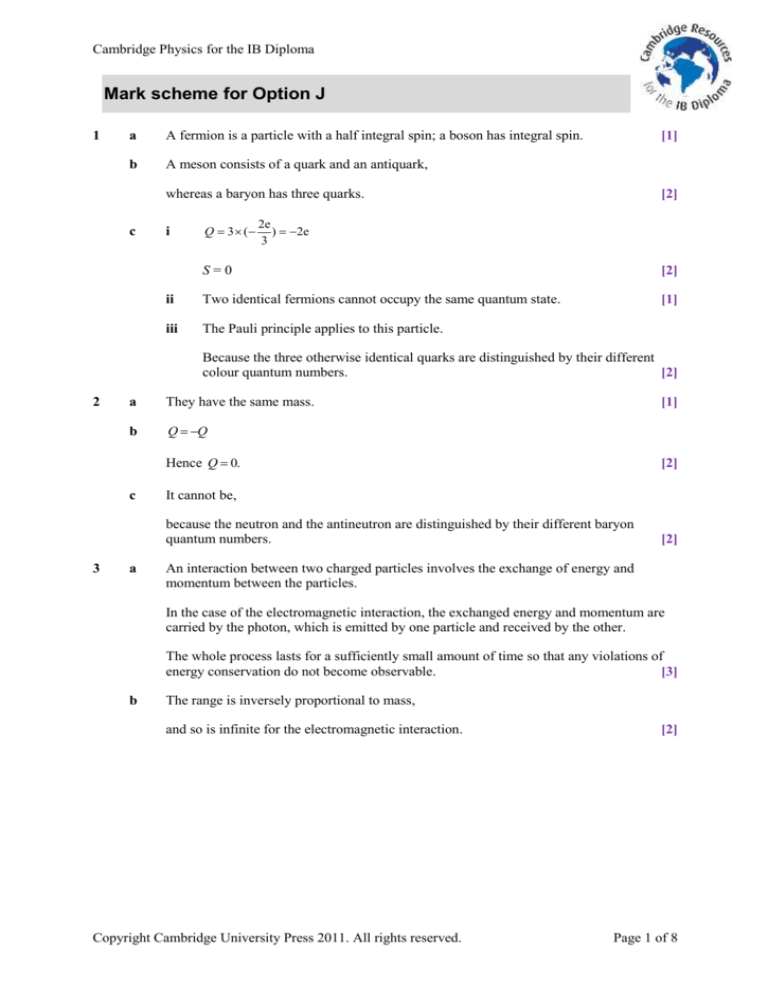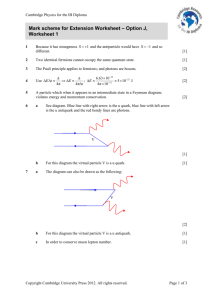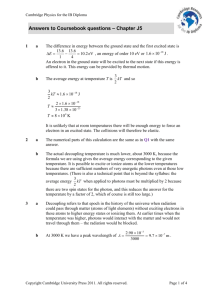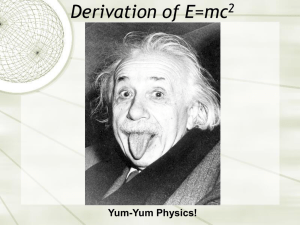
Cambridge Physics for the IB Diploma
Mark scheme for Option J
1
a
A fermion is a particle with a half integral spin; a boson has integral spin.
b
A meson consists of a quark and an antiquark,
[1]
whereas a baryon has three quarks.
c
i
Q 3 (
[2]
2e
) 2e
3
S=0
[2]
ii
Two identical fermions cannot occupy the same quantum state.
[1]
iii
The Pauli principle applies to this particle.
Because the three otherwise identical quarks are distinguished by their different
colour quantum numbers.
[2]
2
a
They have the same mass.
b
Q Q
[1]
Hence Q 0.
c
[2]
It cannot be,
because the neutron and the antineutron are distinguished by their different baryon
quantum numbers.
3
a
[2]
An interaction between two charged particles involves the exchange of energy and
momentum between the particles.
In the case of the electromagnetic interaction, the exchanged energy and momentum are
carried by the photon, which is emitted by one particle and received by the other.
The whole process lasts for a sufficiently small amount of time so that any violations of
energy conservation do not become observable.
[3]
b
The range is inversely proportional to mass,
and so is infinite for the electromagnetic interaction.
[2]
Copyright Cambridge University Press 2011. All rights reserved.
Page 1 of 8
Cambridge Physics for the IB Diploma
c
i
W
[2]
Z0
ii
R
6.6 1034
100 109
4π (
1.6 1019 ) 3 108
(3 108 ) 2
[2]
9.8 1019 1018 m.
Exam tip: notice the conversion of mass from GeV c 2 to kg.
d
i
R
6.6 1034
;
140 106
19
8
4π(
1.6
10
)3
10
(3 108 ) 2
[2]
1015 m
ii
Protons and neutrons are described in terms of quarks.
One gluon exchange in incoming proton/neutron.
One gluon exchange in outgoing proton/neutron.
d
u
u
d
d
u
d
u
d
u
d
u
Copyright Cambridge University Press 2011. All rights reserved.
[3]
Page 2 of 8
Cambridge Physics for the IB Diploma
4
a
b
i
It is virtual (because it cannot be observed due to colour confinement and
so must join another particle after a very short time).
[1]
ii
Up (gluons do not change flavour).
[1]
iii
Green and antiblue.
[2]
i
Because if it did the baryon would have colour,
and in QCD colour is confined.
OR
It would violate the Pauli principle,
ii
5
a
because the three quarks would be identical.
[2]
No, because it would violate colour confinement.
[1]
i
electron
electron
photon
electron
electron
[1]
ii
electron
positron
muon
photon
antimuon
[1]
Copyright Cambridge University Press 2011. All rights reserved.
Page 3 of 8
Cambridge Physics for the IB Diploma
iii
photon
photon
photon
photon
[1]
iv
d quark
u quark
W+
electron
antineutrino
[1]
Copyright Cambridge University Press 2011. All rights reserved.
Page 4 of 8
Cambridge Physics for the IB Diploma
v
photon
u quark
photon
u antiquark
Exam tip: it is ok to draw the ‘vertical’ line above, but draw it slanted if you prefer. The following
diagrams are equivalent to the one above.
photon
u quark
u quark
photon
u antiquark
photon
photon
u antiquark
[1]
6
a
To resolve an object of size d, the wavelength used must be of the same order of
magnitude as d.
So, in this case, it is of order 10 15 m.
b
[2]
The quarks are much smaller than a nucleus,
and so a much smaller de Broglie wavelength is required.
Copyright Cambridge University Press 2011. All rights reserved.
[2]
Page 5 of 8
Cambridge Physics for the IB Diploma
7
a
A liquid kept just below its boiling point has its pressure reduced so it begins to
boil.
Bubbles from the boiling liquid will first form along the path of any charged particles
that are moving through the liquid at that precise time.
A magnetic field bends the path of the particle into a circular path whose radius can be
measured if a photograph of the path is taken.
[3]
b
The path of the particle is photographed and the radius R of the circular path in the
magnetic field is measured.
From R
mv
the momentum mv may be determined if first a reasonable estimate of the
qB
charge is made.
c
[2]
The data taken by the proportional wire chamber are digitized,
and therefore can be analysed much faster by a computer (as opposed to by a person in
the case of bubble chamber photographs).
OR
In the case of the bubble chamber there is a ‘dead time’ in between photographs (there is
no such thing in the case of the proportional chamber),
so there is continuous collection of data in the case of the proportional chamber.
8
a
[2]
Charged particles are inserted in a region of constant magnetic field and follow a circular
path in split electrodes called the ‘Dees’.
An alternating potential difference is established between the two ‘D’s whose frequency
is the same as the frequency of revolution of the particles.
The particles are accelerated every time they cross the gap between the two ‘D’s.
Exam tip: you may want to draw a diagram to help you with your answer here.
b
Determination of speed in terms of radius: qvB
[3]
[3]
mv 2
qBR
v
.
R
m
2
c
Emax
1 2 1 qBR
q2 B2 R2
mv m
2
2 m
2m
Emax
(1.6 1019 )2 1.52 2.02
6.89 1011 J 431 430 MeV.
2 1.67 1027
[3]
i
A meson (because of baryon number conservation).
[1]
ii
Zero (by electric charge conservation).
[1]
iii
EA2 2 (140) 2 (430 938) 9382 1402
EA 7384 M X c2 7384 940 6444 MeV M X 6.4 GeV c 2 .
Copyright Cambridge University Press 2011. All rights reserved.
[2]
Page 6 of 8
Cambridge Physics for the IB Diploma
9
a
Charged particles travelling in circular paths enter cavities to which an
alternating voltage is applied.
The voltage is synchronized with the particles so that they always ‘see’ an accelerating
(and not a decelerating) voltage each time they enter the cavity.
[2]
b
The radius of the path of a charged particle in a magnetic field is qvB
mv 2
mv
R
.
R
qB
Exam tip: you must make some reference to the radius and its dependence on the magnetic field.
As the particle accelerates, v increases but the radius has to stay constant.
Hence B must be variable (it must increase.)
c
[2]
The energy in a collision is 14 TeV:
3
kT 14 TeV
2
T
10
a
2 14 1012 1.6 1019
1.11017 1017 K.
3 1.38 1023
[3]
Experiments in which hadrons
receive large amounts of energy and momentum from bombarding particles (leptons). [2]
b
i
Deep inelastic scattering experiments measure the probability that a particular
constituent will carry a certain fraction x of a baryon’s momentum (the ‘structure
function’).
Experiments show a value of about x
1
, indicating the presence of 3 charged
3
constituents in baryons.
[2]
Exam tip: the syllabus states to ‘analyse results of deep inelastic scattering experiments’, so some
detail is expected here.
ii
Experiments measure the total momentum of the hadron and the total momentum
of the charged constituents.
The two are not the same, indicating the presence of neutral constituents (the
gluons).
[2]
Exam tip: the syllabus states to ‘analyse results of deep inelastic scattering experiments’, so some
detail is expected here.
iii
Asymptotic freedom is the decrease of the interaction strength as the energy
transferred in the interaction increases.
The scattering pattern from hadrons is consistent with particles that very loosely
interact with each other.
[2]
Copyright Cambridge University Press 2011. All rights reserved.
Page 7 of 8
Cambridge Physics for the IB Diploma
11
a
The energy required is 2me c 2 and so
T
4m2 c2
3
kT 2me c2 T
2
3k
4 9.11031 (3 108 )2
7.9 109 1010 K.
3 1.38 1023
[2]
b
There is no limit (electrons and positrons annihilate each other at any temperature).
c
In the early hot universe electrons and positrons annihilated each other but also high
energy photons created electron–positron pairs out of the vacuum.
[1]
As the universe cooled down (to below the answer to a), the process of annihilation
continued but not the process of pair creation, leaving the matter that we see today,
because in the early universe there was a slight amount of extra mass over antimatter. [3]
Exam tip: notice the detail required.
12
a
[2] max from
The fundamental building blocks of matter in string theories are tiny onedimensional strings as opposed to zero-dimensional point particles.
String theories are formulated in more than the 4 dimensions of particle physics.
String theories can in principle provide a quantum theory of gravity; theories based
on particles have failed to do that.
[2]
b
The extra dimensions are curled up into compact manifolds,
and so are essentially unobservable at ordinary energies.
Copyright Cambridge University Press 2011. All rights reserved.
[2]
Page 8 of 8






